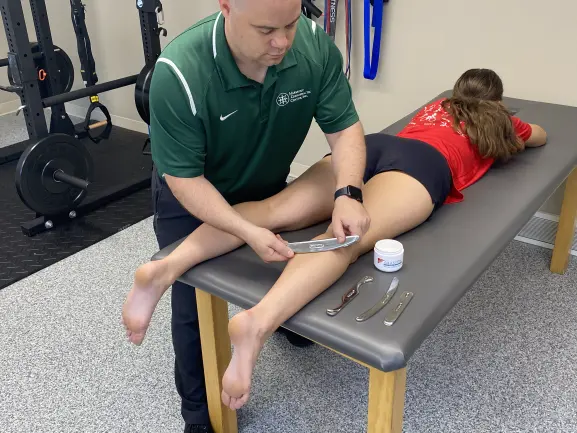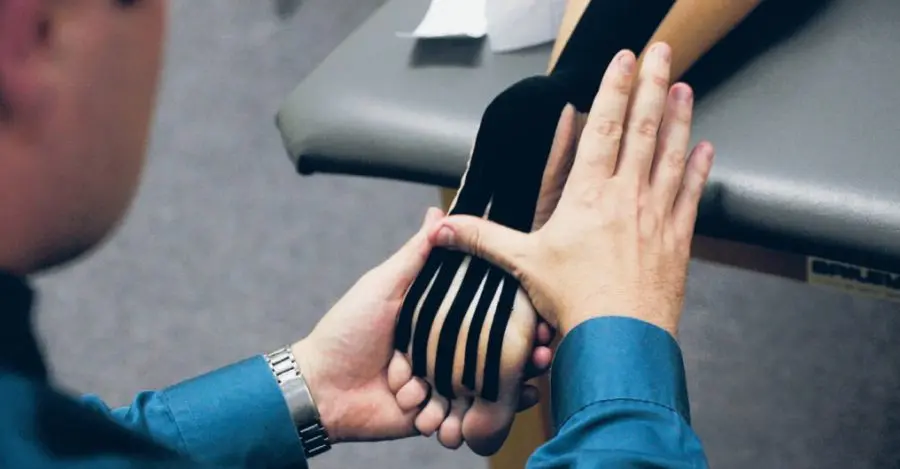Return to Running after an Injury – Toledo, OH
Unfortunately, running has inherent risks for certain types of injuries like plantar fasciitis, iliotibial band syndrome, patellar tendinitis and knee bursitis. Despite the best efforts of runners to run through the pain, these flareups of pain are sometimes best treated by prolonged periods of rest. Many runners have reluctantly come to this conclusion. No really. It’s true even if you don’t want to hear it. Those runners that do decide to take a rest often eventually get there after the problem has actually made them limp back home or if it’s a nagging injury that keeps popping back up. Sometimes rest is enough, and sometimes more advanced treatment (like Graston Technique) is needed in order to help fix the problem. But when the pain starts to dissipate, most runners will be itching to get back out on the road. That drive to train long and hard often sets runners back because they return to running lacking a proper plan.
While runners try and recover, it must be noted that the runner need not be sedentary. Depending on the injury, you might do something that does not involve the injured area. Options might include single leg exercises on the uninvolved leg, upper extremity exercises for those with a leg injury or even something non-weightbearing like swimming. A fascinating fact is that based on our neurology, exercises aimed at the uninvolved limb can actually improve muscle strength in the involved limb. Being active can help to ease the anxiety of not being able to run that you would want to. Being active can also help you to not lose your cardio capacity while you’re resting the injured leg.

There are multiple different phases of the healing process after an injury occurs. The initial phase is characterized by an inflammatory, which lasts approximately 2 to 3 days after injury and is part of normal tissue healing. In many people, the inflammatory phase is heightened in its response or last for too long causing collateral damage to local tissues in the process. Injured tissues can easily be re-inflamed so directly stressing the injured area is not recommended despite your goal being a quick return to running. Properly recovering from an injury involves preventing further damage, restoring motion, restoring strength/ stability and re-establishing coordination.
The next phase of injury consists of the repair phase. When inflammation is reducing, tissue repair is beginning as soon as two days post-injury and may last up to two months. While the tissue is repairing, it is not very resilient, but it needs some stress to encourage proper healing. I feel like I have the tendency to talk about goldilocks a lot in the office. and this is one of those situations where a little bit of stress can be a great thing, but it is really easy to go overboard and overstress an injured area. The final phase of tissue healing is where the repaired tissue is strengthened and remodeled, which can last for months to years after an injury. Each of these different phases can differ for areas of the body can be affected by factors like age, lifestyle, severity of injury and diet/nutrition.
how to get back running after injury
Shortly after an injury, the pain can be greatly reduced compared to where it initially was. It is important to note that just because there is less pain with activity does not mean that the injured tissues are fully healed. Many runners attempt to do too much too soon and can further damage injured tissues and prolong their recovery time. There are five reasonable steps in order to make sure that you return to running after an injury correctly by gradually stressing tissues and improving their strength and durability
- Put out the fire
- Evaluate Goals
- Frequency
- Distance
- Speed
Putting out the Fire
Because of the fact that you trying to actively recover from an injury, you need to be aware of the fact that your body may not want to cooperate. You need to act like a fireman at the ready and plan on taking steps to reduce inflammation in the affected area. I’ve written about this in other places that you can find in the Sports Medicine section of my blog.
There may be some controversy in physical medicine circles, but I do think that ice can be used to help people cope with pain and inflammation. Over-the-counter pain relievers can also be used as directed on the package to help control pain as well but please realize that there are risks associated with pain relievers like ibuprofen, naproxen and acetaminophen. Healthy eating is another thing that can be used to help reduce your levels of inflammation and possibly your pain. Also, don’t just assume that you need to stretch out the area because that might make the problem worse.

A thorough evaluation can be an important step in determining the cause of the irritation and can invaluable to return to running after an injury. Using something like the SFMA can also help pinpoint areas that need to be addressed.
Treatments consisting of chiropractic adjustments, Graston Technique, Kinesio Taping, corrective exercise, massage therapy and custom foot orthotics may be beneficial in relieving pain and inflammation.

Evaluate Goals
Planning your return to running after an injury involves figuring out what your goals are. It’s impossible for me to write this and know what your plan is. Some people have a goal of running three times a week for 3 miles per run. Your goal may be half or full marathon. I had one injured runner who was raising money for charity by running from New York to San Francisco, Forrest Gump style. You need to figure out what your short-term goal is on your way to your long-term goal and actually write it down before you return to running. This is important because this will help hold you back from just tearing it up on the street/trail. During the initial part of the recovery, you are focusing on your short-term goal. While you might want to eventually do a half-marathon, you need to focus on getting your breath back and getting back into the groove so they let you can later build back up.
Frequency
The first thing when you return to running after injury is to try to work towards establishing your desired running frequency per week. You need to pick an extremely low mileage and a slow pace for you and start there. For many people, this is 0.5 to 1 mile per run. You have to be disciplined and decide not to take off for 5 miles after you realize you feel pretty good at the end of that first mile. You need to make sure that your body has the ability to rest and recover in between runs. Get the first run in and see how you feel. If it’s a disaster, then maybe you’re not ready. Maybe you need more rest or maybe you need to do a combination of walk/run. If it does okay then maybe get in a second run that week. When you’re returning to running, I don’t recommend running more than three times a week initially, even if your short-term goal is eventually to work up to five to six times a week. The point of gradually increasing the frequency is making sure that you have enough time between runs for rest and recovery.
Distance
Once you’ve established that initial frequency, then it’s time to work on your average distance. At this point, you just trying to get back into the groove so you should not be doing variations between sprints and long slow runs during the week. When you set your goals earlier you should have figured out an average distance per run that you want to reach. This is the one that’s going to take a little bit of time because you want to slowly work your way up to that distance over several weeks. If you are training for a race, your goal will be the race distance and the date of the race will give you your timeframe for getting to your goal. The speed of each run should remain constant from week to week while you are trying to build your mileage.
Again, you want to start from your extremely low mileage and gradually build up over subsequent weeks. You should add between 0.5 to 1 mile to the previous distance covered. It is better to go slow initially because bumping up your distance too quickly is not going to get you a medal. A runner running three times a week might add 1 mile for the first run of the week and then return to the previous week’s mileage for the second run and then re-add the mile to the final run of the week. Runner “A” might run 2 miles then 1 mile then 2 miles in week two, while Runner “B” might run 2 miles for each run in week two. In week three, Runner “A” may conservatively bump to 2 miles for each run while runner be has increased to 3 miles for each run. The rate at which you add mileage to your weekly runs depends on the timeframe that you set for your goals. Always remember that gradually adding distance is going to be better for long-term recovery when you return to running after an injury.
Speed
Speed is the last thing the work on when you’re trying to get back to running after an injury. This is basically done in the exact same way that you’re trying to increase distance. Use the speed gauge of your choice and increase your speed gradually from week to week and/or run to run. You may increase your speed for one run and then actively rest on the next run by going back to an established speed.

Carefully Return to Running After an Injury
This is a scientific approach to returning to running as you are controlling variables. By controlling distance, frequency and speed, you are able to manage your time under load and the volume of running. You need to push yourself, but you need to do it under control. Overreaching is going to be a normal part of strengthening the system, but you need to do it under control. This will increase your ability to handle load and volume. Most runners are going to end up biting off more than they can chew. Reducing the distance that you run in the week or your speed per run or even taking extra rest by taking a day off can help you get the problem back under control by taking this stepwise approach. Once you’ve established that solid base of running, you can start to expand your training to do things like speed work or long slow runs.
Article Featured in Toledo Roadrunners Club Footprints – Volume 46, Issue 10 (October 2020)
